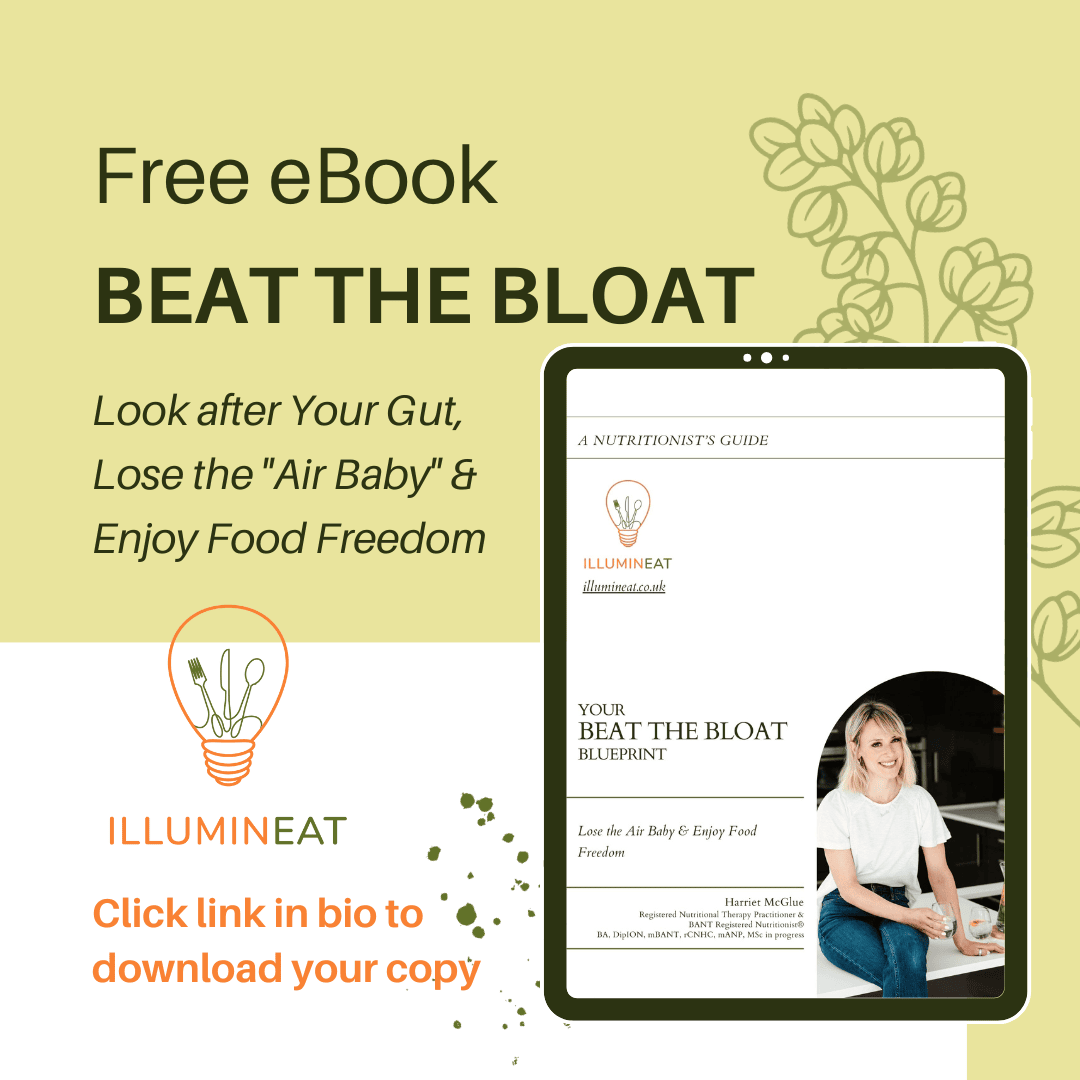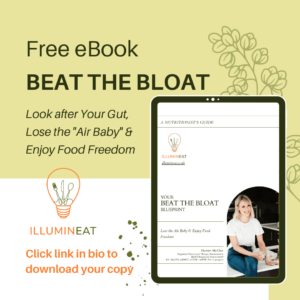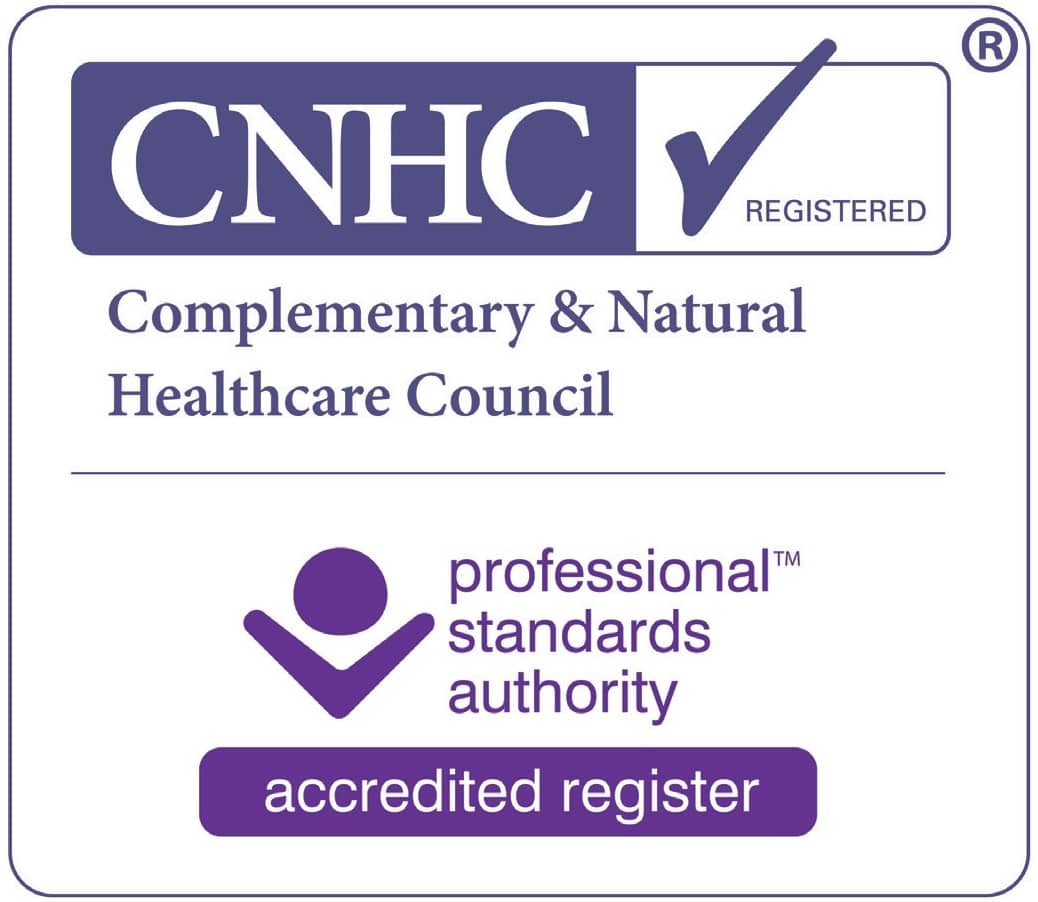Let’s cut to the chase – no. But it’s easy to see where the confusion comes in as they sound similar and are, completely wrongly, often used interchangeably.
Probiotics ARE the gut microbes themselves.
Prebiotics (a class of fibre) FEED the gut microbes.
Let’s start with PREBIOTICS (the food)
I’ve already tackled FIBRE on a previous blog, in which we learned that fibre is basically food for our gut microbes (MB) – which kindly manufacture healthful by-products (called “postbiotics”) for us as they ferment it.
Well, PREBIOTICS are a TYPE OF FIBRE. So all prebiotics are fibre (but not all fibres are necessarily prebiotic (soluble fibres mostly are) because not all can be consumed by our GM and not all have met the rigorous scientific standards required to qualify!).
Types of prebiotic
There are 3 main types: inulin, fructo-oligosaccharides (FOS) and galacto-oligosaccharides (GOS). Anyone familiar with the “low-FODMAP”diet because they suffer with IBS will have come across that term – oligosaccharides. Basically, they are fermentable carbohydrates, which as we’ve discussed means our gut microbes can eat (ferment) them. Together, they are found in over 35,000 plants. Here’s the bottom line: They are VITAL for health.
Should I supplement prebiotics?
You absolutely can buy these in pill or powder form – but that doesn’t mean you should! Oh no. BY FAR the best way of getting prebiotics into your diet is by eating more of the foods that contain them: PLANTS. So veg and fruit, legumes, nuts and seeds, grains etc.
What are the ‘best’ sources of prebiotics?
Very high concentrations of prebiotics are found in onions, garlic, leeks, dandelion greens (if you’re the foraging-sort!), fennel, artichokes, asparagus, green bananas, wheat bran, oats…but there are lots more
It’s not just fibre, though…
And then there’s RESISTANT STARCH, found in oats, legumes, potatoes and rice, which is also fermented by our GMs. Top tip: If you cook then cool your potatoes, pasta or other starch it INCREASES the amount of RESISTANT starch it contains. Not only is this great for our gut bugs, it also results in a steadier rise of blood sugar eating (fewer glucose spikes and dips). The effect persists even if we then re-heat the food. So yesterday’s pasta leftovers suddenly look like an altogether better prospect…
Healthy prebiotics also exist in polyphenols
which are antioxidants that give plants their colour, flavour, aroma etc. Berries, apples, pomegranates, coffee, green tea & chocolate are all phenomenal sources – but pretty much ANY plant is a good source!
Even OMEGA 3 fats are PREBIOTIC, feeding our GMs and releasing healthy postbiotics (though like polyphenols above, they don’t make SCFAs)
Why are prebiotic foods good for me?
As they are by definition fibre, prebiotics offer all the benefits of fibre discussed in my blog on that subject. But their real hero-role is in FERTILISING THE GOOD GUT BUGS and making them GROW and proliferate so they can perform their VERY SPECIAL ROLE.
So, what is that role? To produce some amazing chemical compounds known as POSTBIOTICS. These include short chain fatty acids (SCFAs) which I discussed in my fibre blog and are arguably some of the most HEALING nutrients around. So our GMs NEED PREBIOTICS in order to deliver us their MYRIAD HEALTH BENEFITS.
Health benefits of SCFAs
- Prevent growth of harmful, inflammatory bacteria
- Suppress dangerous bacteria like E coli and Salmonella – ones we’re all familiar with as responsible for nasty bouts of gastroenteritis!
- …supporting a healthy microbiota
- Fuel the cells lining our colon keeping it healthy
- Help prevent – and even fix – “leaky gut” which allows bacterial toxins to seep through gaps in the gut lining & into our blood . Butyrate is most important here.
- Promote motility (so we don’t get constipated)
- Reduce ‘visceral hypersensitivity’ (an overly sensitive gut & common feature of IBS)
- Nourish us, providing 10% of our daily calories
- Reduce systemic (body-wide) inflammation by fixing any imbalance in our microbiota, fixing leaky gut AND making our immune cells more tolerant and less likely to ‘over-react’ (as in autoimmune disease)
It doesn’t stop there…prebiotics in general have been shown to improve blood sugar control, to help regulate appetite, to reduce the likelihood of us needing antibiotics, to support skin health – the list goes on.
Now, what about PROBIOTICS?
These are the LIVING BACTERIA THEMSELVES that have demonstrated health benefits in us humans. You will often see them referred to as gut bugs, gut microbes, good bacteria, healthy or helpful bacteria – I tend to use gut microbes (GM) in my blogs, but they all mean the same thing.
We’re talking the good guys here – SPECIES like Lactobacilli, Bifidobacteria, Prevotella & Actinobacteria. Note that within each species, are hundreds of different STRAINS – something I come onto later re. choosing a probiotic supplement.
Together with all the other bacteria, viruses, fungi etc. in our large intestine, they make up our GUT MICROBIOTA which, together with the GENES of all those microbes, is what is meant by the MICROBIOME (GMs + their genetic material).
Should I take a probiotic supplement?
Probably not. The evidence just doesn’t support it – yet – UNLESS you have certain health issues you want/need to address.
You’ll need to talk to a registered nutritional therapist (NT) or dietitian since it’s only worth trying a STRAIN which has good EVIDENCE OF BENEFIT for your SYMPTOM (eg bloating, diarrhoea) OR CONDITION (eg UTI, eczema). Unfortunately, it’s not as simple as plucking the nearest or cheapest box of ‘probiotics’ off the shelf at Boots! That would be akin to taking paracetamol to fix your UTI…
Your NT will help find a probiotic (matching the pieces and strain) that has demonstrated considerable benefit in others with your particular issue, and ensure you take the same dose and for an appropriate length of time (typically 4+ weeks).
The NT will also ensure the probiotic is by a reputable brand and advise you when to take it (eg before breakfast on an empty stomach) and how to store it (room temp or in the fridge).
If one strain, or blend of strains doesn’t work, you can always try another with good evidence behind it and so on, until you find something that works for you.
Where else can I find probiotics?
FERMENTED FOODS that contain these LIVE bacteria… In a recent study, fermented food consumption increased microbiome diversity and reduced markers of inflammation. In general though, rigorous scientific trials are actually pretty sparse. But as with all nutrition research, we know that proving benefit of a food or diet is a whole different ball-game to provide efficacy of a drug: the food trials are EXPONENTIALLY harder to conduct and therefore fewer and farther between. Remember: absence of evidence is NOT the same as evidence of absence. In other words, just because there aren’t a ton of trials proving they work, there probably IS something about fermented foods. After all, they go back THOUSANDS of years across cultures and ANECDOTALLY many people attest to their benefit. So what’s to lose?
Good sources include kefir, live yoghurt, cheese (especially unpasterised, traditional varieties), kimchi, sauerkraut.
If you opt for kimchi or kombucha, be sure to buy a ‘fresh’ one from the chiller because anything in a jar or bottle has been pasturised killing off the bacteria! And dodge the ones with added sugar or artificial sweeteners. If you’re feeling keen, you could make your own (something I have yet to try…!)
















